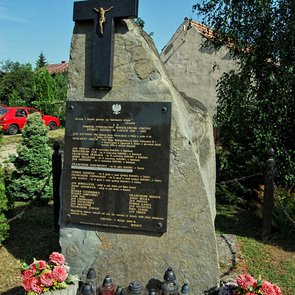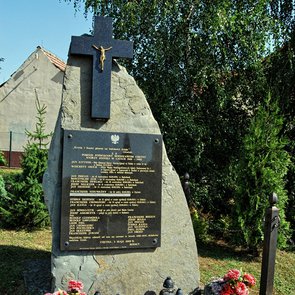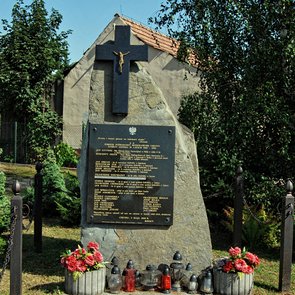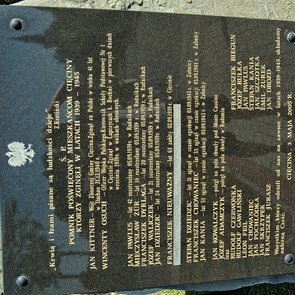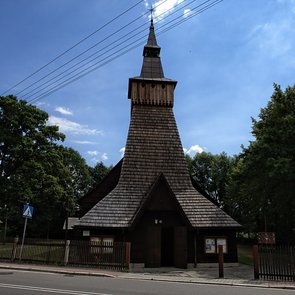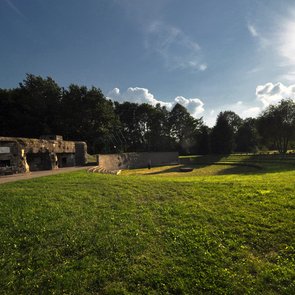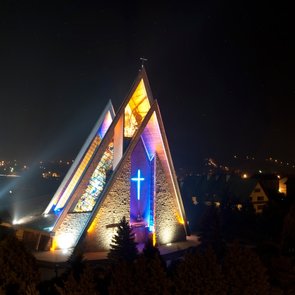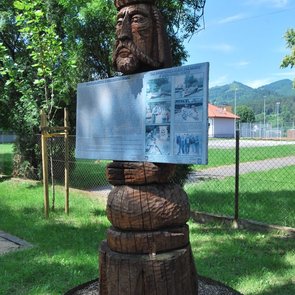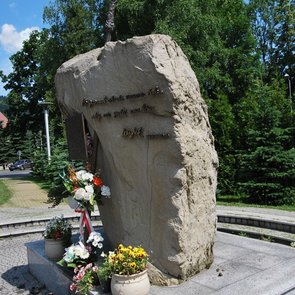In der Mitte des Dorfes Cięcina gibt es ein Steindenkmal zum Gedenken an die Bewohner, die im Zweiten Weltkrieg starben. Das Dorf verläuft entlang der slowakischen Grenze, besteht aus defensiven Positionen: Węgierska Górka-Korbielów- Krzyżowa, und war auf der Achse des erwarteten Angriffs. Die Lage wurde als die bequemste, um mögliche Angriffe Angreifer abzuwehren. Trotz des großen Engagements der Bewohner in den vorbereitenden Arbeiten an Verteidigungsanlagen der Brańków- Berg, der Bau von Verteidigungsanlagen wurde aufgrund der Knappheit der Ressourcen und der Mangel an geeigneten Material und Ausrüstung geendet. Die entscheidende Rolle war hier der Mangel an Zeit für die Umsetzung der so großen Aufgabe. Die Verteidigungslinie hatte die fünf defensive Forts in der Nähe von Węgierska Górka. Die Stellungen wurden angetreten: zwei Unternehmen der Gebirgsinfanterie von Vilnius Bataillon. Die 151 Berg-Artillerie-Batterie verteidigte die Umgebung von Cięcina. Die angreifende Kraft der Bayerischen Infanterie-Division VII war deutlich stärker als die polnische Verteidigungsfähigkeit. Am 3. September 1939, nach einem heldenhaften Kampf gaben ihre Positionen. Nach dem Kampf auf dem Friedhof in Cisiec wurden 9 Polen begraben, die die ersten Opfer des Zweiten Weltkriegs waren. Die Besatzers von Beginn ihrer Herrschaft führten Beschränkungen seinen eigenen Bedingungen ein, und beseitigten alle Zeichen der polnischen Kultur. Die Schule und die polnische Zeitung wurden abgesagt. Polnisch Untertitel und eine Ausgangssperre wurden eingeführt. Am schlimmsten waren Einschränkungen von Lebensmittelrationen, die die Einheimischen zum Schmuggel und Opposition gegen die hohen Vertrags landwirtschaftlichen Produkten aus ihren eigenen Höfen zwangen. Sie wurden oft mit dem Tode bestrafen. Wegen der Nähe zur slowakischen Grenze, wurden "die Einwohner" in der Partisanentätigkeit engagiert. Die Bewohner waren in der Konspiration von Spitzel und Kuriere, die sich mit Flüchtlingen und Übertragung von Intelligenz beschäftigten. Die Menschen aus Cięcina: Biegun Franciszek, Piela und der Aktivist von Pfadfinder - Jan Wojciuch, dank ihrem Mut, retteten viele Guerillas und Soldaten,die in den Westen die Polnische Armee versorgten. Leider nur sehr wenige von ihnen überlebten, weil die Besatzers blutig alle Formen von Widerstand und Ungehorsam behandelten. In diesem Zeitraum, die Nazi-Verwaltung, wie in anderen Bezirken, führte die Vernichtungsaktionen, zu Vernichtung der Polen ab. Eine lokale Intelligenz wurde verhaftet. Die Leute wurden in den Konzentrationslagern exportiert, und es gab auch lokale Hinrichtungen. Um die Opfer der Nachkriegsweltkrieg zu gedenken, schaffte man eine "Liste" der Opfer des Zweiten Weltkriegs. Als Ehrerbietung an die Helden errichtet symbolische Denkmal in Form einer Granit-Boulder, auf dem eine Gedenktafel mit den Namen anbrachte. Bis jetzt war es an der 27 Menschen, die ihr Leben für die Freiheit des Landes gaben. Ein charakteristisches Merkmal des Denkmals ist die Tatsache, dass der Speicher ist immer lebendig und darum konnte man die Liste der Opfer des faschistischen Terrors in Cięcina nicht schließen,weil nicht alle lokale Geschichten von Heldentum überprüft wurden.
Zobacz także


